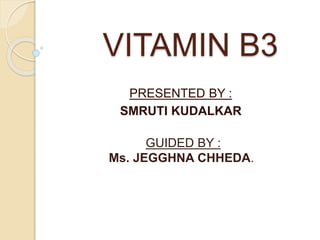
Vitamin B3
- 1. VITAMIN B3 PRESENTED BY : SMRUTI KUDALKAR GUIDED BY : Ms. JEGGHNA CHHEDA.
- 2. VITAMIN B3- NIACIN Introduction Niacin is the generic term for nicotinamide and nicotinic acid Obtained by the oxidation of nicotine is an organic compound with the formula C6H5NO2 Simple derivative of pyridine White crystalline substance Water soluble Resistant to heat, oxidation & alkalis One of the most stable vitamin Can be easily synthesised commercially
- 3. Structure: Niacin has a carboxyl group (COOH) at the 3-position, whereas, in nicotinamide the carboxyl group is replaced by a carboxamide group (CONH2)
- 4. Biosynthesis: The liver can synthesize niacin from the essential amino acid tryptophan, requiring 60 mg of tryptophan to make one mg of niacin. Tryptophan (in presence of Fe) Kynurenine ( NADPH NADP) Quinolinic acid Nicotinic acid Mononucleotide(NMN) NAD Niacin(Nicotinamide)
- 5. Metabolism: The de novo synthesis of NAD and NADPH occurs from quinolinic acid, a metabolite of tryptophan. The conversion of tryptophan to niacin depends on amount of tryptophan and niacin ingested and the Pyridoxine status. (60 mg of tryptophan = 1 mg of niacin) Dietary protein deficiency changes the profile of urinary metabolites as there are changes in the amount of tryptophan being converted into niacin.
- 6. Absorption, Transport & Storage: • Nam and NA are absorbed in the stomach and SI by carrier mediated facilitated diffusion. • Both are transported in the plasma in free solution and each is taken up by most tissues through passive diffusion, although some tissues like erythrocytes, kidney and brain, have a transport system also for NA. • Niacin is retained in the tissues by being converted into NAD and NADPH.
- 7. Functions: Niacin is required by all cells. It plays a vital role in the release of energy from all energy yeilding nutrients-CHO, fat, protein,alcohol. Also required for the synthesis of protien, fat & 5C sugars needed for the formation of DNA & RNA. The biochemical role of niacin is to form part of coenzymes NAD & NADP require by many of the key pathways of the metabolism. Coenzymes NAD and NADPH are electron carriers of cells. NAD is primarily involve in catabolic reactions whereas, NADP functions mainly in anabolic reactions. They are coenzymes for more than 200 enzymes reactions.
- 8. Some of the reactions where niacin in the form of NAD is involved are : 1. Conversion of lactate to pyruvate in glycolytic pathway. 2. Glyceradehyde-3-PO4 to 1, 3 biphosphoglycerate in glycolytic pathway. 3. In biological oxidation reduction complex. 4. α- ketoglutarate to succinyl CoA in TCA cycle. 5. Malate to oxaloactetate in TCA cycle. Niacin in the form of NADP is involved in the following: 1. Glucose-6-PO4 to 6-Phospho gluconolactone in HMP stunt. 2. 6-phospho gluconate to 3 keto-6 phosphogluconate in HMP stunt. Thus they play an important role in mechanisms for DNA repair and gene stability and therefore influence cancer risk.
- 9. Sources Niacin is found in variety of foods- Animal products like milk, eggs, poultry, fish, beef Fruits & vegetables: avocado, potato, leafy vegetables Seeds : groundnut, almonds, whole cereals, pulses
- 10. Recommended dietary allowances Niacin requirement is related to energy intake. For every 1000 kcal intake, 6.6 mg of niacin is to be taken. Infants 0 - 6 months: 2 mg/day 7 - 12 months: 4 mg/day Children 1 - 3 years: 6 mg/day 4 - 8 years: 8 mg/day 9 - 13 years: 12 mg/day Adolescents and Adults Males age 14 and older: 16 mg/day Females age 14 and older: 14 mg/day Specific recommendations depend on age, gender, and other factors (such as pregnancy). Women who are pregnant or breast-feeding need higher amounts
- 11. Deficiency Slight deficiency of niacin can lead to irritability, poor concentration, anxiety, fatigue, restlessness and depression. Severe deficiency: PELLAGRA: caused by decreased intake of niacin or tryptophan and possibly by excessive intake of leucine. It occurs in the middle age population 20-50 where both the sexes are equally affected. Pellagra is classically described by "the four Ds" Dermatitis- cracked skin, pigmented, scaly dermatitis Dementia- involves CNS leads to confusion, disorientation and neuritis Diarrhea and other digestive disturbances
- 12. Symptoms Clinical features: loss of weight & incresing debility. Diarrhoea & mental changes are not present in mild deficiency. Dermal lesions: photo sensitive rash seen on exposed body surface like lower & upper extremities, face & neck. On the neck, the lesions appear in the form of a necklace called Casal’s necklace.
- 13. Symptoms contd. Gastrointestinal changes: the mucous membrane is inflammed resulting in severe glossitis , stomatitis, oesophagitis, gastritis & entertis. The inflammation can produce bloody diarrhoea. Neurological manifestation: higher mental functions are deranged in pellagra. Insomnia occurs. As the disease progresses it can manifest in disorientation, hallucination & delirium. Acute encephalopathy characterised by clouding of conciousness occurs.
- 14. Treatment Pellagra can be cured by a good diet containing adequate amounts of protien, tryptophan and/or niacin as well as other members of B-complex group of vitamins. A moderately severe case requires nicotinic acid or amide in doses of 100-300 mg/day orally. Mental symptoms respond within 24-48 hours & the dermal lesions require 3-4 weeks of therapy. Most cases of pellegra require riboflavin & pyridoxine particularly for neurological manifestation. Oral terapy is satisfactory in all cases except in those with very severe diarrhoea.
- 15. Prevention Pellagra can be prevented by the following measures: 1. Replacing sorghum with other cereals. 2. Consuming sorhgum with good quality protiens. 3. Fortifying bread with niacin. 4. Distributio of yeast & niacin tablets as public health programme. 5. Developing low leucine strains of sorghum. 6. Including groundnuts in every day diet.
